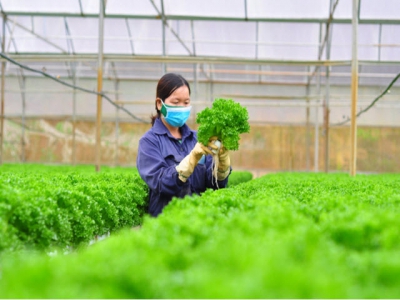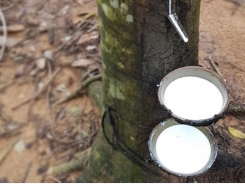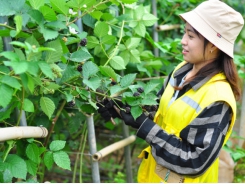Agriculture sector is committed to meeting the USD 44 billion export target

Deputy Minister of MARD Phung Duc Tien believed that Resolution 105 will act as a lever to assist the agriculture sector in reaching USD 44 billion export goal and serving as an economic pillar.
Governmental Resolution 105, which was issued on September 9 and focuses on assisting companies, cooperatives, and business families during the Covid-19 pandemic, is seen as a catalyst for economic growth in a variety of professions.
However, since the resolution was entrusted to specialized ministries, agencies, and local governments, its effectiveness is contingent on how the resolution is actually implemented in the production direction.
Pursuing goals
Could you perhaps explain the mechanism by which Governmental Resolution 105 achieves its goal of restoring agricultural production?
Businesses, cooperatives, and business families all contribute significantly to the growth of the socioeconomic system, budget collection, and job creation. Vietnam has been under intense pressure during Covid-19 to achieve the dual goals of pandemic protection and economic growth in 2021.
Resolution 105 was issued in this regard in order to alleviate problems and bottlenecks and to assist in stabilizing the new production cycle in the last months of the year and the following years.
Agriculture, in contrast to other sectors, is unusual in that farmers must labor in fields, rivers, and ponds. Additionally, agricultural companies continue to be tiny and dispersed, with inadequate infrastructure, outdated processing techniques, low adoption of high-tech, and a limited value chain.
When a pandemic occurs, a series of complications arise, including capital as non-consumable products, stalled circulation and distribution at the district and commune levels, labor reductions and the absence of a reproduction process for facilities with F0 cases, an increase in material, seed, and transportation costs, and a slow rate of vaccination.
Regarding the agricultural sector, Deputy Prime Minister Le Van Thanh addressed the Conference personally on September 13 and outlined three major objectives for the industry, including output recovery; circulation and distribution promotion; and achieving the 44 billion USD export goal in 2021.
What will MARD do in response to the government's directive to help companies, cooperatives, and business families in reorganizing their operations?
MARD will conduct an assessment of all companies and cooperatives in the provinces and cities that operate in the four most impacted product categories, namely agriculture, husbandry, fishery, and forestry, particularly those that use social distancing measures. For the new production season, the Ministry will prepare seeds, input materials, veterinary medicines, plant protection pharmaceuticals, and vaccinations.
Additionally, we will conduct theme conferences to address specific problems affecting each industry. Special attention should be paid to the processing sector with a high added value.
The government will also encourage exports in addition to the aforementioned categories. Despite the rise in July and the decline in August, the overall export turnover from January to August was still USD 32.13 billion, with a surplus of USD 3.35 billion. Along with production recovery, export is a critical objective. As a result, the agricultural sector will make every effort to guarantee the greatest possible circulation and sale of agricultural, forestry, and fisheries goods.
There were previously worries that the agriculture industry would struggle to meet the USD 44 billion export goal. However, given the outlook for recovery after the pandemic, we will work to accomplish the objectives, ensuring that agriculture continues to be the economy's backbone.
Concentrate on identifying avenues for output
As stated in Government Resolution 105, agricultural, forest, and fishery goods shall be produced and distributed on a case-by-case basis depending on aggregate, production forecast, quality, and selling link supplied. How effective is this approach after an epidemic has been contained?
Commercial transactions shifted throughout the Covid-19 era. Agriculture, like the rest of the economy, must adapt to changing demands. As a result, MARD established two working groups in the south and north to get a better understanding of agricultural production, circulation, and distribution.
Clearly, Covid-19 disrupts the chain of linkages. We keep normal production but redistribute during outbreaks. Consumption has been reduced as a result of the closure of restaurants and hotels. Thus, the whole process must be recalculated, from production to consumption, distribution, and food security for 100 million people, as well as export.
Parallel to achieving production stability, the MARD will work with the Ministries of Industry, Trade, and Finance to provide local guidance on traceability, stamping, and labeling. Simultaneously with the decision, the ministry will coordinate efforts to offer timely advice and resolving problems.
In accordance with Resolution 105, the Government encourages ministries, departments, branches, and local governments to take the initiative, rewarding those who think, act, and take responsibility for proactive innovation, creativity, and flexibility in resolving production bottlenecks. How will the MARD make use of them?
Numerous businesses cannot afford to guarantee the creation of "three on-sites" or "one road - two destinations" concepts. The government is currently promoting increased production for institutions and businesses that can assist in pandemic prevention and control operations, including green workers, health, factories, and communities. To organize a suitable production that is not stereotypical and adheres to rigorous guidelines.
The MARD and the Ministry of Health determined that agriculture, forestry, and fishing must be excluded from production facilities in line with Resolution 105. Assisting in the expansion of markets both domestically and internationally. Only in this way will agriculture be able to avoid the "devaluation season."
Although the epidemic has had a negative impact on Vietnam's economy and productivity, it has taught us valuable lessons. For instance, many models continue to ensure supply chain capacity in large industrial networks.
Despite its 1.5 million hectares, the Mekong Delta rice harvest (Mekong Delta) was mainly gathered during the summer-autumn season when the green channel was opened for interior canal traffic.
This implies that by coordinating our preparation and understanding the situation, we may overcome difficulties.
It is essential for ministries, departments, and branches to work together to accomplish a common goal. What are your particular suggestions for MARD?
The Ministry of Industry and Trade suggested that the Ministry of Foreign Affairs and the Ministry of Industry and Trade collaborate to promote agricultural products in order to get official access to a wide number of countries.
We propose to the Finance Ministry that businesses be free from taxes, land use fees, energy, and water charges.
In cooperation with the State Bank, develop a unique loan package for companies, cooperatives, and farming families.
Continue to facilitate product mobility, both domestically and globally, in cooperation with the Ministry of Transportation.
Concentrate your efforts with the Ministry of Health on encouraging local governments to assess "three on-sites" companies to ensure they match the agricultural production model while also providing a foundation for larger-scale production.
Arrange for human resources on-site in cooperation with the Ministry of Labor, Invalids, and Social Affairs to ensure that industries, food, and food processing companies may resume operations.
Có thể bạn quan tâm
Phần mềm

Phối trộn thức ăn chăn nuôi

Pha dung dịch thủy canh

Định mức cho tôm ăn

Phối trộn phân bón NPK

Xác định tỷ lệ tôm sống

Chuyển đổi đơn vị phân bón

Xác định công suất sục khí

Chuyển đổi đơn vị tôm

Tính diện tích nhà kính

Tính thể tích ao hồ



 Vietnamese farmers are keenly interested in digitization
Vietnamese farmers are keenly interested in digitization  Approximately 100% of China’s dragon fruit imports from…
Approximately 100% of China’s dragon fruit imports from…